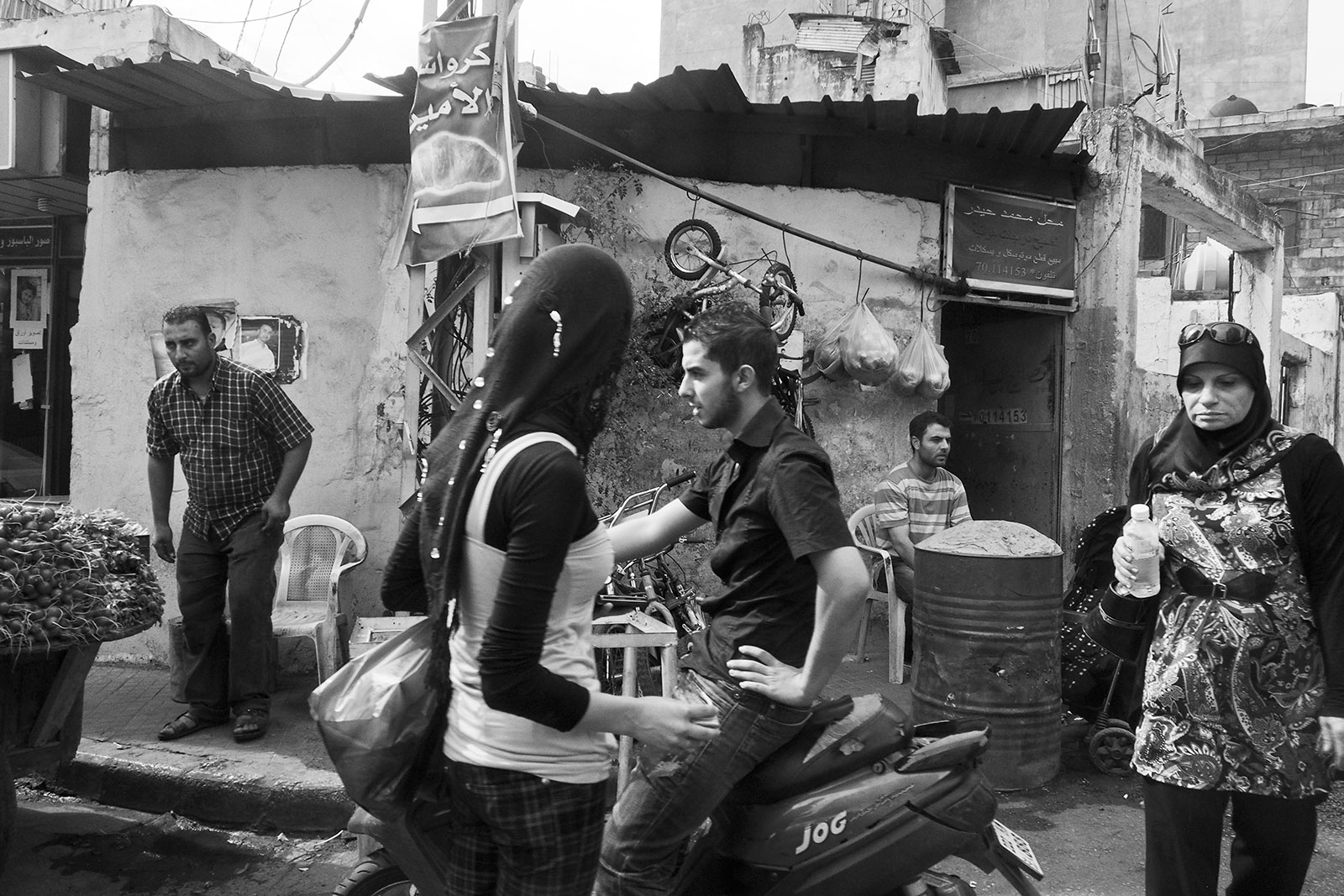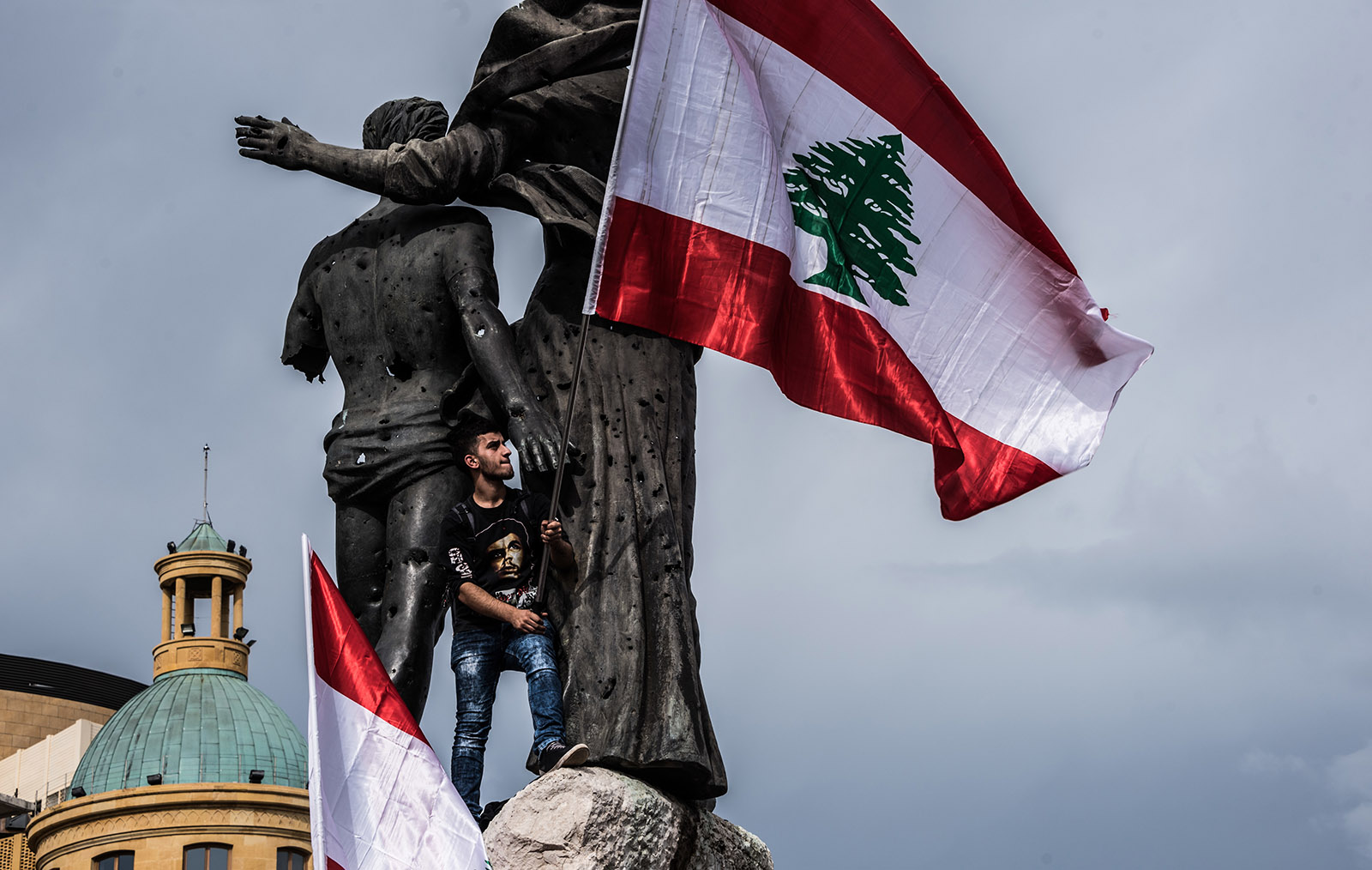Beirut—Lebanon is both the center of the world and a dead end. The broken little village of a planet that is sick. Chaotic, polluted, and corrupt beyond belief, this is a country where beauty and human warmth constantly find ways to break through. It is impossible to name that feeling of being assaulted and charmed at the same time. You are in the city center, you stroll down a sidewalk eighteen inches wide, assailed from all sides by the confusion of buildings and traffic, torn between the appeal of the sea and the stench of garbage, and suddenly your gaze is soothed by the play of light on a stone wall, by bougainvilleas cascading from an ancient balcony, by the balcony itself.
You continue on your way, head down. Refugee children’s eyes beg you for something to eat, your impatience gives way to sadness and guilt. You hurry into a shop to buy some reels of yarn, and it’s the beginning of a journey. The stranger welcomes you as if he’s been waiting for you since yesterday. He offers you a coffee, asks for your news, gives you his, and tells you his life story as he aligns the reels on a cluttered counter.
As you leave the shop, you feel the way you do when you have just finished reading a great novel: a little different. That is certainly common in Mediterranean countries, but in Lebanon, it’s always ramped up a notch. The intimacy is so genuine and shameless that suddenly it transforms the social scene into a theater stage. An odd combination of infantilism and maturity generates a feeling for which there is no word.
It would hardly be an exaggeration to say that in Lebanon, everything can be explained and nothing can be understood. All the decisions made for this country are made behind its back, and all that happens here epitomizes the rest of the world: the mix of populations, the vulnerability of borders, political lying at its worst, building the present by destroying the past, an utter lack of perspective. With a total population of 4 to 5 million, Lebanon is home to 1.5 million refugees. Between a quarter and a third of the population is foreign: Palestinians displaced by the wars of 1948 and 1967, Syrians and Palestinians fleeing repression and the war in Syria that began in 2011, Iraqis displaced by the two Gulf wars. Lebanon’s degree of absorption and hospitality is almost proportional to its degree of intolerance. Ambivalence is everywhere, in everything.
We know more or less what constitutes Lebanon, but we don’t know how it works. If we had to send into space a country capable of containing the world, Lebanon would fit the bill. If we had to send one that did not contain what is needed to make a real country, Lebanon would also be the answer.
The Maronite Christian president, General Michel Aoun, is reliant on the support of Hassan Nasrallah, the leader of Hezbollah, to stay in power—even though the armed forces of this Shia party are a threat to the authority of the Lebanese army. Lebanon is a testbed of provisional solutions to insoluble problems. In the same way that Israel always feels in danger of making peace, the Lebanese political class is forever in danger of acting for the public good.
For Lebanon’s rulers, salvaging the present requires destroying the future, and their own survival depends on maintaining their internal conflicts. With every political leader propped up by the support of their clan, clan warfare ensures the survival of the leaders. As the crow flies, only a few hundred metres separate the Shia suburb of Beirut and the predominantly Christian Achrafieh neighborhood, but the gulf that divides these two districts is comparable to the fault lines that separate continents.
Uniquely hospitable, Lebanon is also home to the vilest forms of racism. On the one hand, if you simply walk through a village, you will be invited up for a coffee by people sitting on their balconies. On the other, it is reported every other week that a foreign servant, very often an Ethiopian immigrant, has thrown herself from a high window. The act is immediately dismissed as an accident or a coincidence, the case dropped with no further action taken. Up and down the country, at the entrance to many villages, giant billboards have recently appeared advising that “foreign workers and their families are prohibited from walking in the city’s streets.” Activists, journalists, and artists do something to preserve the country’s honor by alerting the public to the outrage of such racism and xenophobia. But the shame is still crushing.
Advertisement
Some 360,000 Lebanese live in dire poverty while the politicians pocket bribes that run to hundreds of millions of dollars. Everyone wants an end to the stealing and plundering of resources by the political leaders. Only a tiny minority, though, is striving to achieve this. The situation makes people angry, but does not give rise to demonstrations, or very few.
Nor do the figures tell one much about the Lebanese reality; they are constantly being distorted by life itself. Horizontally tiny—about 4,000 square miles—the country is vertically vast. It is a physical and mental hotchpotch of beliefs, inventiveness, allusions, horrors, and flashpoints. All extremes and all clumped together. It is like a magician’s trick handkerchief: you simply unfold one end and it will stretch ad infinitum. Individual memories are rich and compelling while the collective memory is nowhere to be found, impossible to recount. Every Lebanese invents a personal Lebanon for a country that does not exist.
Since the country’s civil war, which began in 1975 and ended in 1990, identities have been determined by religious communities, of which there are eighteen. Just as the Arab world in general first became Islamized and then split into Islamic sects, Lebanon has once again been in the vanguard and gone farther still. People are Shia, Sunni, Maronite, Druze, or Greek Orthodox before being poor or oppressed. Or again, they are Shia, Sunni, or Druze before being of the same religion. The levers of social rebellion are thus compromised by the workings of segregated communities.
And the more deficient and corrupt the state is, the more possessive and enmeshed is people’s relationship with their God. Religious symbols are everywhere, prayer is on all lips. You can no longer ask directions or buy a pound of onions without Christ or the Prophet being invoked. Musa—the Arabic name for Moses—is never far away. According to the Qur’an, Moses spoke directly with God, without a go-between. The day these three figures take a back seat, the region will doubtless start to breathe again.
Religion’s comeback is a particular blow for those who recall the time, half a century ago, when women celebrated the end of the veil and when secularism was uppermost in people’s minds. Barring a few notable exceptions, power is in the hands of men, both at state level and within the home. The degree of women’s submission varies greatly depending on social class. It was a Sunni woman, the current interior minister Raya El-Hassan, who recently revived a proposal that civil marriage should be legitimized, but the bill was rejected. It will doubtless be women who inspire the change in mentalities in the future. In the meantime, their situation remains alarming in some milieus, especially in the numerous refugee camps around the country where the humiliation experienced by men frequently degenerates into sexual abuse and domestic violence—with impunity.
As the country becomes more and more fragmented, so religion increasingly binds on the one hand, divides on the other. This dubious equation is spreading globally, but as in so many things, Lebanon is a step ahead when it comes to emerging symptoms and hopeless remedies. The Arabic word for nuance is farq saghir: small difference. Needless to say, Lebanon takes the prize for “small differences.”
The stronghold of nuance and of caricature, it is the permanent fount of infinitely subtle and pointless arguments, with all concerned having a vested interest in ensuring the permanent imbalance. The Lebanese beat all records for splits, divisions, and contradictions. They are cynical and sentimental, tired and full of energy, capable of bending over backward for family and friends, incapable of uniting for the sake of the country.
Speed is a reflex, second nature. When a driver is stuck in a traffic jam, his hand on the horn immediately takes over from his foot on the accelerator. It is less an attempt to move forward than a way of not giving up when everything is falling apart. That small difference encapsulates the fine line between Lebanese defects and virtues: anarchy and vulgarity on the one hand, and the courage never to admit defeat on the other.
Something similar applies to Lebanon’s landscapes—the physical space and the mental space operate in the same way, characterized by the compatibility of opposites. If you leave the city, you grow used to going from hot to cold every five minutes. From north to south, unregulated construction disfigures the coastline. The few rare vestiges of a former paradise stir memories of the times when slabs of concrete had not yet walled off the sea. In the countryside, the light and natural scenery are unique, but the hills are crawling with the palaces of the nouveau riche, hideous buildings, and unfinished breeze-block houses, forcing the eye to keep switching from fields of poppies to fields of garbage.
Advertisement
In places where the development craze has not yet, or not completely, taken over, the ancient stone houses and the richly varied vegetation create an immediate, magical connection between nature and history. When not marred by giant portraits of politicians on billboards, an age-old oak or an olive grove suddenly evoke centuries of silence and conversations. There is something biblical about each of these small oases. At sunset, the colors are tinged with gold. Seeing the sky sculpted by the undulating mountains, you forget the smallness of the country at their foot. Then you feel a deep love for the place you’d loathed an hour before.
It can take a very tiny thing for this fragmented, divided population to come together as a single being. Almost nothing: an impromptu conversation in a shop, a waiting room, an airport, a taxi, during a condolence visit, on a street corner, in an elevator—the slightest of these encounters is capable of erasing in a few seconds all the differences I have described. Or rather, the differences then merge in such a way that they suddenly form a mood, an agreement, a resemblance, a hermetic, indestructible whole, that can be called the Lebanese miracle. A sort of shared pleasure in saying the same thing differently.
Transfer this scenario to the entire planet and you could achieve world peace. But the tragedy is that Lebanon’s miracle is connected to a timer, like a bomb.
This essay was translated from the French by Ros Schwartz.




